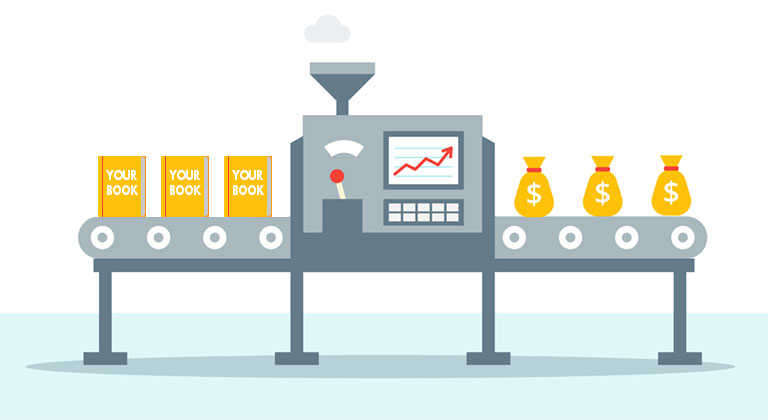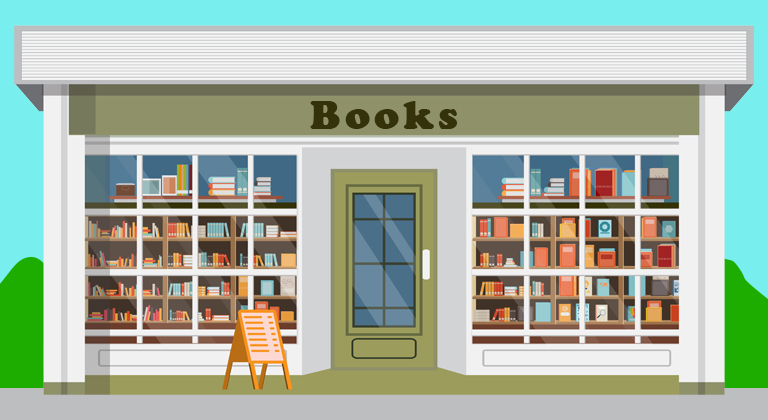Successful Self-Publishing – It’s All About the Conversions
Advertising expert Ginger is back this week with some more thoughts on what happens after you’ve written and published your book – specifically how to advertise, promote and hopefully sell copies to eager readers! Today, he’s talking about the cornerstone of any successful promotional campaign – conversions.
A couple of weeks ago, I wrote an article about how to make sense of your Amazon Advertising facts and figures – and I had a few questions from readers about one important aspect of that: Conversions.
Conversions are the technical term for when you ‘convert’ a visitor to your Amazon product page to a paying customer; or, in short, when they buy your book!
In terms of successful self-publishing, any promotional efforts you make to drive potential customers to your product page need to result in a good percentage of ‘conversions’ – otherwise you’re leading horses to water, but none of them want to take a drink. The problem is, there are a lot of very humbling questions you need to ask yourself if you’re not getting the conversion rate you hoped for.
What makes a ‘convert’?
My background is in advertising and marketing, and I’m old-school enough to have been in this industry before even Google started dominating the arena. Back in the ‘old’ days in which I used to write and sell advertising spots on radio, television and billboards, the philosophy of most advertisers was: If you throw enough… ahem… stuff at the wall, some of it will stick. Most companies compared the amount they were spending on advertising with any uptick in sales, and assumed that one had led to the other.
Then the dot-com revolution happened, and Google changed the industry forever. Thanks to the Internet, Google was able to track a sale (or ‘conversion’) from the first time somebody typed something into their search engine, right through the moment they clicked buy on whichever website they turned up at. This meant advertisers were suddenly inundated with data about which advertising worked for them, and which didn’t; and could adjust their tactics accordingly.
Today, that same situation exists on Facebook, Advertising on Amazon and any other digital advertising space. You can drill down to the number of ‘impressions’ your advert gets (how many times people see it) then the ‘cost per click’ as people actually follow that advert to your product page, and finally the ACOS – or ‘average cost of sale.’ It enables advertisers large and small to know what kind of return on investment they’re getting for their advertising dollars (if any.)
For those of us in self-publishing, the biggest stumbling block in advertising – whether you’re promoting your book in a sponsored newsletter, on Facebook, or using Advertising on Amazon – is the number of people you pay money to drive to your product page (your ‘cost per clicks’ multiplied by the number of actual clicks) compared to the number of people who actually click ‘buy now.’
Getting 100 clicks to your product page might mean that your advertising is effective… but if it doesn’t translate into actual sales, you’re paying money for nothing.
Likewise, if you’re getting 4 clicks and half of them convert into sales, you’ve got access to a scalable advertising campaign that will basically multiply however much money you decide to pour into it.
That’s the dream scenario – but it’s not one most authors experience. Conversion rates are generally around the 1 in 10 range, they’re prone to fluctuation, and there are other factors at play, too (like how much of your sale price you actually get to keep as profit.) At the end of the day, most authors don’t have a huge amount of money to spend on advertising, so you want that money to work hard for you – and conversions are the key to making a return on your advertising investment.
How to gauge your Conversions
If you’re going to spend even a few dollars on advertising, you need to do your homework. We’ve moved on from the days of “throw enough stuff at the wall, and some of it will stick.” Whether you’re using advertising on Twitter, Google, Facebook or Amazon, you’ll be able to get access to a ton of information to help decipher how effective your advertising is. In some cases, you might not be able to get specific data – for example, on Facebook you can track clicks through to your product page, but not whether they click buy now on Amazon. And although Advertising on Amazon will tell you how many people bought your book from an ad, they won’t tell you how many of the clicks you receive are from people who borrowed your book via Kindle Unlimited page reads…
…but you should be able to get an idea.
If nothing else, if you compare the sales of a specific book during a specific period without any advertising to the same period during which you were advertising, you should be able to figure out if there was a significant bump in sales and pagereads or not. It’s not an exact science, but that bump can safely be assumed to come from advertising, and so it can give you a rough idea of your return on investment (for example, if you spent $100 on advertising, and saw a $100 spike in sales/pagereads during that period, you can generally assume that you’re earning your advertising dollars back.)
The big point here is to work out how much of that advertising spend results in conversions – sales. Whether you’re getting the exact data from Amazon, or seeing a pattern roughly in the figures (say, you’re getting 100 clicks from Facebook, and getting a spike of 10 additional sales from it) you’ll know how many people arrive at your product page, and how many of them ‘convert’ into paying readers. If your conversion ratio is poor – or non-existent – then you have issues that need to be addressed.
As one of my old-school Advertising Agency bosses once said: “You can spend all the money on advertising in the world, but if people don’t want to buy your product, they won’t.”
The same is very true today; especially when it comes to self-published books. If you’re getting people to your product page, but they’re not clicking ‘buy now’, you need to figure out what’s wrong.
Why aren’t people buying?
Unfortunately, the reasons for people not buying your book after clicking through to your product page are less easy to define than all the other factors in whether your advertising is working or not. It could be a multitude of issues – but there is some good news.
Whether they come from Facebook, Twitter or Advertising on Amazon, if people are clicking on your adverts, it means they are interested in what you have to offer…
That’s a start!
That means your advertising, sales message or book details are attractive; and it means you’ve got the potential to identify and fix whatever the roadblock is to actually converting that traffic into paying readers. This is a much better situation to be in than getting tons and tons of impressions (your advert is shown to loads of people) but none of them are interested in finding out more.
But what could the problem be?
Here are some common issues, and how to address them:
1 – Your blurb isn’t compelling
If somebody took the time to click on your ad, whether on Facebook or Advertising on Amazon, it means that the title of your book, and the cover or advertising image, was compelling enough to get them to tap their mouse button. That’s a good start.
But before people click ‘buy now’ they’ll generally read the blurb – and this could be where you’re getting caught up.
I know for a fact that a compelling blurb will get me reading quicker than anything – and a drab one will have me click the ‘back’ button before you can blink.
We recently interviewed author Jordan Vezina and the blurb of the first novel in his series, Among Wolves, got me hooked the moment I read the first line:
Born of rape. Raised by Nazis. Circumstances have given Will Hessler every excuse to become a monster. Instead, he’s going to become the one hunting them.
How can you read that a not want to learn more?
A compelling blurb needs to have an addictive hook that demands somebody buy the book to find out more. Romance novelist Elle Thorpe had even non-romance readers hooked with the concept of her novel Only the Positive, in which the tropes of the romance genre are thrown on their head when the hero faces the possibility that he might have infected his heroine with HIV. Obviously, we know there’s going to be a happily-ever-after… but damn we need to find out how!
If your book is getting traffic, but not conversions, take a look at your blurb and see if it communicates the core conflict of your story – the issue that has to be overcome for the heroes to triumph, for love to conquer all, or for good to overcome evil. Often, just identifying that single thread and highlighting it in the blurb can make a big difference.
In fact, I’d go one further… One bold move – which is effective, but even I don’t do it as often as I should – is to write the blurb before the novel. This might sound like madness, but when you think about it, there’s a certain power to writing a compelling blurb…
…and then writing a book that focuses on what made that blurb compelling.
Movie producers have something they call an ‘elevator pitch’ – in which they explain the basis of the movie they’re pitching in the time it takes for you to ride up in an elevator with a producer. Alien was famously described as “Jaws in space” and the Steven Seagal movie Under Siege was described as “Die Hard on a boat.” The concept behind Sharknado speaks for itself.
What’s the ‘elevator pitch’ of your book? That should be your blurb.
2 – Your reviews are sketchy
One of the toughest parts of self-publishing is getting a solid number of genuine reviews – that’s why programs like Hidden Gems exist in the first place! More established authors develop their own lists of selected readers to do essentially the same thing – post reviews as soon as their book goes live on Amazon. This kickstarts the sales process and is essential to most author’s success.
However, the problem with genuine reviews is just that – they’re genuine. This means authors have no control over what people write. Even if you use an ARC service – which offers an ‘Advanced Reading Copy’ of your book in the hopes that the reader will post a review – there’s no guarantee what that review will be. In short, if you book isn’t great, nor will the reviews be.
This is a VERY bitter pill for most authors to swallow – and I speak from experience. Over the years I’ve probably received well over a hundred 1-star reviews, and the majority of them – for my earlier books – I probably deserved. In my experience reviewers have always given my stories the benefit of the doubt but, at the end of the day, there IS a thing called the “reader/author contract” in which readers have certain expectations about what a book should deliver; and if you fail to meet those expectations, you’ll be dinged for it.
Whether it was because the book contained errors and typos (a reminder to hire an editor) or story elements that are incongruent with the genre (a romance story with cheating, for example) you’ll find reviewers can sometimes be a pretty blunt and unforgiving lot. A smart author will take these bad reviews on the chin and use them as feedback to improve their work (I very rarely get bad reviews in my own books now) but the impact can still be harmful to a book when it comes to conversions.
If your book has a bad rating – an average of 3-stars and below – you’ll find fewer people will risk clicking the ‘buy now’ button even if they were initially attracted by the cover and concept. In those circumstances, it might even be worth pulling the book and doing a brutal rewrite and edit rather than throwing good money after bad in advertising a book that advertises its own shortcomings.
Conversely, you CAN find you have too many good reviews! While Amazon has cracked down on companies that used to ‘sell’ fake reviews, the damage has been done. Some studies show that buyers are less likely to trust a product that only has very positive reviews because they believe them to be fake, preferring to pick products that have a more realistic distribution of scores (although obviously skewing on the high end) because they seem more realistic and honest. Essentially they recognize that everyone is different and have different tastes and opinions, so it’s unlikely that everyone will absolutely love and rave a particular book or product without at least a few detractors.
All of this can be a frustrating roadblock to getting conversions – since it’s part of the process that often feels out of an author’s hands – but it’s an important one. All I can say is that writing is a craft, not an art – and craftsman have to learn their skill. Read reviews, take action on what they say, and improve each book you write. Your writing will improve, and eventually so will your average rating.
#3 Your Advertising reaches the wrong audience
One often overlooked roadblock to converting traffic into paying readers is the fact that your ads might be reaching the wrong audience. If your cover is attractive and your reviews are good, a potential reader might click through to your product page – but immediately think: This isn’t for me.
This isn’t necessarily anything to do with you – it might just be that a thriller reader clicked through to your romantic suspense book… but they’re not into romance books. A sci-fi fan might read the blurb and think that your book leans too heavily into fantasy. On Facebook, authors who don’t use the ‘book cover on a Kindle’ format in their ads often experience people clicking on their adverts because of the compelling graphics and copy, only to find themselves on Amazon and think: “Oh, wait, this is a book?”
Of all the roadblocks to conversions, this is perhaps the easiest to solve. When you’re Advertising on Amazon, eliminating keywords that drive clicks but low or no conversions will reduce your spend and give you a better return on investment. Finding which keywords work best for you and identifying other similar ones can score you more sales. On Facebook, using the ‘lookalike’ feature to create audiences for your ads that are more likely to convert will help significantly.
These are more advanced tactics – some of which can be intimidating to authors who aren’t from an advertising background like I am. We’ll be posting more about leveraging advertising tweaks this way in the future, and for a tailored 1-to-1 consultation with an advertising expert, just shoot us an email.
Don’t take poor conversions personally – but do take accountability for them.
I mentioned earlier that some of the harsher aspects of self-publishing – like poor reviews – can be a bitter pill for authors to swallow. Your reaction to them will define your self-publishing career.
Authors either get bitter, or get better…
You can tweak books and improve your conversions, but it’s often very difficult to turn a poorly-performing book into a well-performing one. In my writing career, I’ve always focused on trying to write the next book rather than trying to fix the previous one. It’s a more productive use of your time, because each new book you write will be better than the last as long as you’re open to accepting areas in which you can improve your offering.
You don’t need to compromise on your literary vision – but you might need to polish it.
This is the toughest lesson for any writer to learn. We get so invested in writing books, and put so many months of effort and hundreds or even thousands of dollars into publishing and promoting them, that it’s brutal when they don’t sell like we’d expected or hoped them to.
But the first and most important lesson a writer can learn is that nobody is obligated to read your book.
Read successful books in your genre. Learn their styles and beats. See what factors make them successful – the shared elements in the concept, blurb and cover – and don’t cut corners when it comes to editing or revision. Write the best damned book you can, then polish it until it shines, and then move on and promise to do even better with your next book.
Successful writers are constantly learning. Constantly improving. Constantly writing…
…and even the best of them often only have a single-digit percentage of conversions.
So don’t take things to heart – don’t let any stumbling blocks derail your passion for writing and publishing. If you have the self awareness to identify areas in which you can improve your craft, you’ve already taken the path towards overcoming them and becoming a successful writer.
And if there’s one thing I think it’s important to remember, it’s that you have the potential to earn far more from poor conversions than you ever will from easy conversions. Maybe not initially, and maybe not in financial terms (at first) but because you’ll learn from them.
The rare authors who ‘hit it out of the park’ with their early books (and, again, I speak from experience after hitting a bestseller in the second book in my series) often have a rude awakening when they fail to recapture lightning in a bottle and end up wondering, just like the song from The Producers: “Where did I go right?”
Authors who’ve learned the hard way – from building little revenue bumps on each new book – end up having a much more sustainable income, and earn much more loyalty from readers. They’re the authors earning the full-time salaries from writing four or five years down the line; and they deserve to, having paid their dues.
Every time you fail to turn your advertising traffic into a ‘conversion’, you do take a step towards your own ‘conversion’ into a more successful author.












Excellent article Ginger! Just as a side-note: if you’re advertising on Facebook, you can use your affiliate link to track who actually buys your books. I know it’s frowned down upon by Amazon, but I’ve been doing it a while and they’ve never said a word.
Also, authors must keep in mind that if their book is in KU, they could be getting clicks and “orders.” Give the KU page reads time. Everyone that orders your book in KU won’t begin reading it immediately. If you watch your Amazon ranking closely enough, you can see how orders affect rank, although if you’re getting sales AND orders it’s harder to distinguish which is happening.
The KU page reads is the trickiest part of finding out if your ads are profitable. As a reader myself, I’ve ordered books many times and didn’t start reading them for a month. Until Amazon allows us to see “orders” then we’ll be somewhat in the dark.
Thanks for the great info and good luck to every author out there!